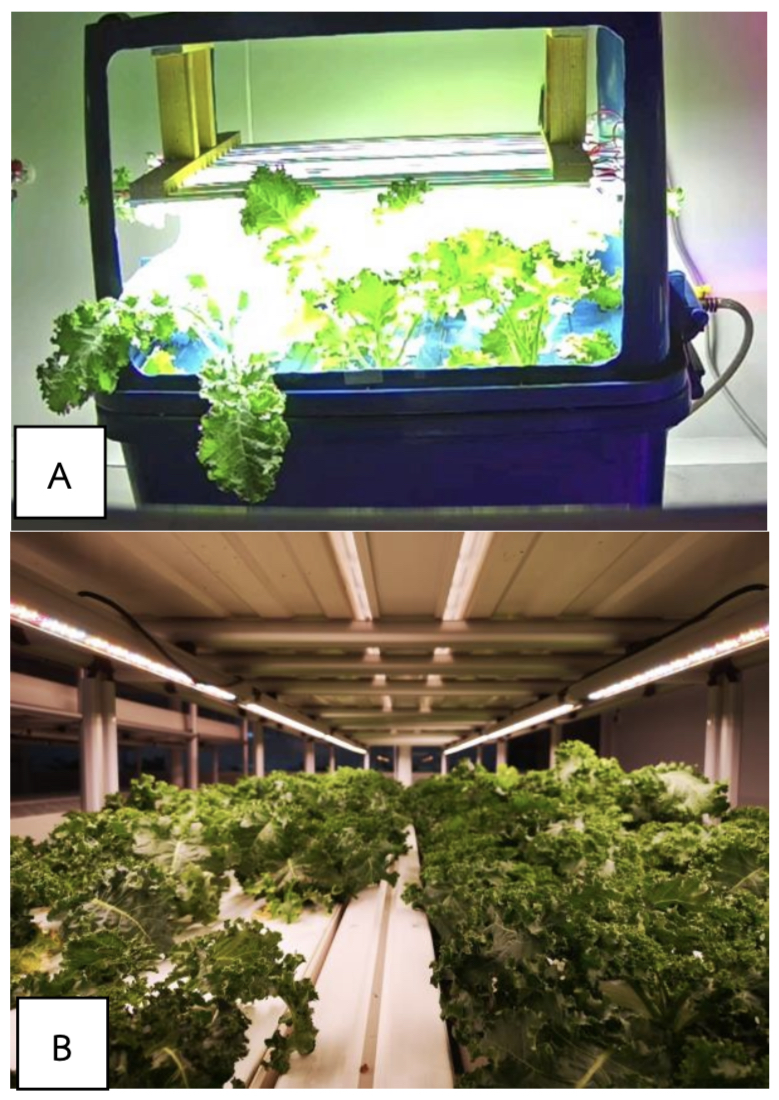ชุดปลูกผักระบบรากสัมผัสอากาศภายในอาคารด้วยแสงเทียม Indoor Aeroponics cultivation systems with Artificial Light
Main Article Content
บทคัดย่อ
บทคัดย่อ
การออกแบบและจัดสร้างชุดปลูกผักระบบรากสัมผัสอากาศภายในอาคารด้วยแสงเทียม มีวัตถุประสงค์เพื่อต้องการให้คนในเขตเมืองสามารถปลูกผักรับประทานในครัวเรือนที่มีพื้นที่จำกัด โดยพัฒนาชุดปลูกให้มีน้ำหนักเบา ราคาถูก มีประสิทธิภาพเพียงพอและสามารถควบคุมการเปิดและปิดอุปกรณ์ได้ด้วยสมาร์ทโฟน โดยมีขั้นตอนการดำเนินการ คือ 1) ออกแบบและจัดสร้างชุดปลูกผักระบบรากสัมผัสอากาศภายในอาคารด้วยแสงเทียม และ 2) ทดสอบประสิทธิภาพการทำงานของชุดปลูกผักที่สร้างขึ้นกับชุดปลูกผักระบบ DRFT ภายในอาคารด้วยแสงเทียมที่เป็นแบบการค้า ผลการวิจัยพบว่า ชุดปลูกผักระบบรากสัมผัสอากาศภายในอาคารด้วยแสงเทียมที่สร้างขึ้นมีต้นทุนการผลิตประมาณ 2,000 บาท มีน้ำหนัก 6 กิโลกรัม สามารถปลูกผักได้ 9 ต้น มีระบบแสงเทียม และสามารถควบคุมการเปิดและปิดอุปกรณ์ได้ด้วยสมาร์ทโฟน สำหรับการทดสอบประสิทธิภาพของชุดปลูกผัก ดำเนินการโดย เพาะเมล็ดคะน้าใบหยิก(เคล) ในแผ่นฟองน้ำเพาะกล้าเป็นเวลา 7 วัน จากนั้นทำการย้ายไปปลูกในชุดปลูกผักระบบรากสัมผัสอากาศภายในอาคาร และชุดปลูกผักระบบ DRFT ภายในอาคารด้วยแสงเทียมที่เป็นแบบการค้า เพื่อสังเกตการเจริญเติบโตและศึกษาการทำงานของชุดปลูกเป็นเวลา 42 วัน ผลการทดสอบพบว่า คะน้าใบหยิกที่ปลูกในระบบปลูกรากสัมผัสอากาศ มีน้ำหนักสด 269.67±5.11 กรัม มีน้ำหนักแห้ง13.48±0.25 กรัม มีความยาวราก 55.88±2.82 เซนติเมตร ในขณะที่คะน้าใบหยิกที่ปลูกในระบบปลูก DRFT มีน้ำหนักสด 276.30±6.15 กรัม มีน้ำหนักแห้ง 13.83±0.16 กรัม มีความยาวราก 38.81±1.15 เซนติเมตร เมื่อทำการเปรียบเทียบค่าเฉลี่ยแบบ T-test พบว่า ค่าเฉลี่ยน้ำหนักสดและน้ำหนักแห้งของคะน้าใบหยิกที่ปลูกบนระบบปลูกทั้ง 2 ระบบไม่มีความแตกต่างกันทางสถิติ ขณะที่ความยาวรากมีความแตกต่างกันอย่างมีนัยสำคัญยิ่งทางสถิติที่ระดับความเชื่อมั่นร้อยละ 95 โดยคะน้าใบหยิกที่ปลูกในชุดปลูกผักระบบรากสัมผัสอากาศภายในอาคารด้วยแสงเทียม จะมีรากที่ยาวกว่าคะน้าใบหยิกที่ปลูกในชุดปลูกผักระบบ DRFT ภายในอาคารด้วยแสงเทียมที่เป็นแบบการค้า
คำสำคัญ: ชุดปลูกผักในอาคาร , แอโร่โปนิกส์, ชุดปลูกผักในอาคารด้วยแสงเทียม
Abstract
The indoor aeroponics cultivation systems with artificial light were designed and constructed to respond to the needs of people who are living in urban areas which are limited space. It has been developed to be lightweight, inexpensive, efficacy and can do it myself. The process has consisted of 1) design and constructs the indoor aeroponics cultivation systems with artificial light and, 2) the efficacy was done by comparing it with the commercial DRFT crop set with artificial lighting. It was found that the indoor aeroponics cultivation system with artificial light has 9 planting channels with 6 kilograms overall weight. The construction cost less than Baht 2,000. The growth of kale was observed. The efficacy testing was lied out in the T-test. There are two types of cultivation systems, 1) the aeroponics cultivation systems with artificial light and, 2) the commercial DRFT cultivation systems with artificial light. The efficacy testing was done by sowing the seed of kale for 7 days and then transfers the seedling to both types of cultivation systems for 42 days. The growth of kale stems was observed and collected to determine the fresh weight, dry weight, and root length of each stem. It was found that the kale grown in the aeroponics cultivation systems with artificial light had fresh weight, dry weight, and root length as 269.67±5.11 gram, 13.48±0.25 gram, and 55.88±2.82 centimeter respectively. While, the kale that grown in the commercial DRFT cultivation systems with artificial light had fresh weight, dry weight, and root length as 276.30±6.15 gram, dry weight 13.83±0.16 gram, and root length 38.81±1.15 centimeter respectively. The kale grown on both cultivation systems has shown no significant difference in fresh weight and dry weight. However, there was a significant difference at a 95% confidence level in root length. The kale is grown on the aeroponics cultivation systems with artificial light had longer roots than the kale is grown on the commercial DRFT cultivation systems with artificial light.
Keywords: indoor cultivation systems, aeroponics, indoor cultivation systems with artificial light
Article Details

อนุญาตภายใต้เงื่อนไข Creative Commons Attribution-NonCommercial-NoDerivatives 4.0 International License.
สมาคมวิศวกรรมเกษตรแห่งประเทศไทย
Thai Socities of Agricultural Engineering
เอกสารอ้างอิง
ธรรมศักดิ์ ทองเกตุ. 2551. เอกสารประกอบการฝกอบรมการปลูกพืชโดยไมใชดิน. สํานักสงเสริมและ ฝึกอบรม. มหาวิทยาลัยเกษตรศาสตร วิทยาเขตบางเขน, กรุงเทพฯ. : มหาวิทยาลัยเกษตรศาสตร์.
นพดล เรียบเลิศหิรัญ. 2546. เอกสารประกอบการสอนวิชาการปลูกพืชโดยไมใชดิน. ภาควิชา พฤกษศาสตร คณะวิทยาศาสตร มหาวิทยาลัยเกษตรศาสตร์. กรุงเทพฯ. : มหาวิทยาลัยเกษตรศาสตร์
วัสกา ดวงอ่อนนาม. 2559.ชุดปลูกผักไร้ดิน KUS-58 สำหรับสภาพพื้นที่จำกัดในเขตเมือง.วารสารวิชาการเกษตร 34(2),150-160.
อุดมพงษ ตวงประยงค์. 2552. การพัฒนาการปลูกผักกาดหอมโดยไมใชดินแบบแอโรโพนิกส์. วิทยานิพนธ ปริญญาวิทยาศาสตร์มหาบัณฑิต. กรุงเทพฯ : มหาวิทยาลัยเกษตรศาสตร.
Li, Q.; Li, X.; Tang, B.; Gu, M. 2018. Growth Responses and Root Characteristics of Lettuce Grown in Aeroponics, Hydroponics, and Substrate Culture. Horticulturae, 4(4)35.


